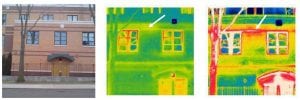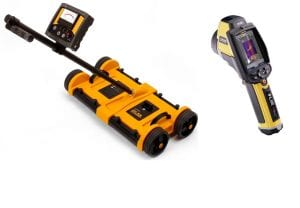SUPERSTRUCTURES’ Principal Paul Millman introduced our latest lunch-and-learn seminar with a phrase familiar to physicians: “First, do no harm.” No, we’re not expanding our practice to include medical procedures, but the analogy is apt for non-destructive testing, the subject of the day’s presentation, “Everything You Always Wanted to Know About Infrared Thermography (and Electrical Impedance) Testing…But Were Afraid to Ask” by Barry Drogin, our Director of Non-Destructive Testing & Evaluation. Like the latest medical diagnostics tools, infrared cameras and electrical impedance meters offer a non-invasive assessment of the “patient” (in this case, a building).
In his talk, Barry gave a comprehensive overview of the science behind IR and EI testing, their applications for various kinds of roof, wall, and fenestration investigations, and the finer points of interpreting the results. With both diagnostic tools, there’s literally more than meets the eye, but the first and most important step is knowing which device is right for the building element, materials, light, and weather conditions in question. All of these factors can impact the effectiveness of IR and EI.

For example, IR cannot be used on a ballasted roof. Such images may resemble a lovely Pointillist painting, but they’re not going to tell you anything useful about roof membrane failure. On the other hand, under the right weather conditions, IR can be effective for imaging interior insulation in framed roofs and can even detect missing mass in a wall. For most roof applications, EI testing is preferable. Among the few exceptions are roofs with an aluminized paint coating. Also, EI won’t work on pre-war slabs constructed with cinder material containing iron.

Not only does SUPERSTRUCTURES have the tools and in-house expertise to utilize IR and EI to their fullest for non-destructive testing, we also believe that educating agencies and building owners in its potential applications is good policy.
14 Wall Street, 25th Floor, New York, NY 10005
(212) 505 1133
info@superstructures.com
Subscribe to SuperScript, our email newsletter.